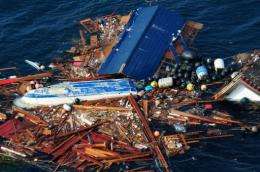Japan's tsunami debris set for 10-year Pacific tour

Debris sucked from the shoreline of Japan by the March 11 tsunami has embarked on a 10-year circuit of the North Pacific, posing an enduring threat to shipping and wildlife, a French green group says.
The 9.0-magnitude earthquake and tsunami created an estimated 25 million tonnes of waste, "countless quantities" of which swept out to sea when the wave receded, Robin des Bois (Robin Hood) said.
The debris includes dense forms as diverse as planes, ships, cars and chemical tanks, which after sinking will become an inshore hazard for trawlers and the environment by leaking oil, fuel and industrial fluids, it said.
Thick mats of floating wood and plastic will take between one and two years to cross the Pacific and then split into two large patches, the group said in a report dated May 31.
One will head northwards parallel to the eastern Pacific coast, drifting on the Alaskan Current.
The other will head southwards, floating on the California Current.
Part of this southerly debris will split off, joining a gentle vortex of well-documented waste in the eastern Pacific that is called the Eastern Garbage Patch.
The rest of the southern branch will then head back across the Pacific under the North Equatorial Current, which will take it to the so-called Western Garbage Patch.
"The entire voyage around the North Pacific could take around 10 years," Robin des Bois said.
It pointed to many hazards for the environment, including the breakup of plastic into tiny particles called "plastic plankton" which accumulates in the food chain.
In March, a computer model devised by researchers at the International Pacific Research Center at the University of Hawaii predicted Hawaiian beaches would see the first pieces of debris washing up around a year after the disaster.
(c) 2011 AFP



















